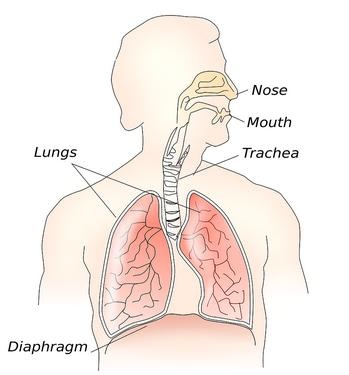Breathing exercises |
|
The breathing rhythm and the heartbeat rhythm are a kind of synchronizers for all other processes. Inhale and exhale: the working conditions of the heart have changed dramatically. Another was its position, the forces of external pressure, the conditions for the flow of blood and its outflow through the vessels. In accordance with the respiratory rhythm, the nature of the blood supply to all organs also changes. If you strengthen the synchronous activity of the central nervous system and respiratory organs, you can see how it has a calming and even somnolent effect on a person. The electronic sleep system is based on the use of this phenomenon. The breathing rhythm captured by a special sensor is transmitted to a small screen that glows brighter and more subdued. It is enough to watch such a program for 15-20 minutes to fall asleep soundly. However, you can achieve the same without any electronics. For many hundreds of years, Indian yogis have mastered the method of synchronizing breathing and the activity of the whole organism.
Abdominal breathingThis is how men usually breathe. When inhaling, the diaphragm drops and the abdomen swells; when you exhale, on the contrary, the diaphragm compresses the lungs and in this it is helped by the abdominal press, which squeezes the abdominal organs, which in turn press on the diaphragm. Resting abdominal breathing provides the greatest volume of air. At the same time, the lungs are stretched downward, their base (lower and middle part) is filled with air. The rhythmic lowering of the diaphragm produces a gentle massage of the internal organs located in the abdomen. Costal breathing
Clavicular breathingSuch breathing is carried out due to the movement of the collarbones, which makes it possible to fill only the uppermost part of the lungs with air. This type of breathing requires the most effort. But, on the other hand, it involves in the respiratory process those parts of the lungs that usually take an insignificant part in breathing. Full breathAs already mentioned, complete breathing includes all three types, combining them into one whole, into one continuous wave-like movement. Inhalation begins with abdominal breathing and ends with clavicular breathing, exhalation is the opposite. In the process of such combined breathing, no part of the lungs remains unfilled with air. Full breathing, as the basis for all yoga breathing exercises, must be mastered first. Remember the basic rules.
How to practically master the method of full breathing? First, you need to work on its individual phases, and then try to combine them into a common free, undulating movement.
To begin, take a few deep breaths and breaths, pulling in your stomach as you exhale and protruding it as you inhale. After several long, deliberately slow breathing movements, the desire to breathe more fully will certainly appear. Try to breathe only with your belly. After you completely empty your lungs and hold your breath for a few minutes, you will feel that the inhalation is asking for itself. Relax the abdomen and let the abdominal muscles work on their own: air enters without any effort and, while it fills the lungs, the abdomen bulges out due to the lowering of the diaphragm. At the same time, inhalation occurs smoothly, completely, without effort. The abdomen enlarges slowly, like a ball that is inflated; the muscles remain relaxed. To control movement, place one hand on your stomach and the other on your chest. The ribs remain motionless during abdominal breathing. We remind you that all your attention should be focused on the breathing process, and breathing itself should be carried out only through the nose. Once you have mastered abdominal breathing, you can start training full breathing. Start by exhaling fully. Then inhale slowly and smoothly into the stomach; when you feel that the belly can no longer swell, connect the chest, starting to expand the lower ribs. Take your time! When the ribs are fully extended, lift the collarbones. After filling your lungs to the end, try to inhale at least a little more. Hold your breath. Now go to exhale. All steps are in reverse order. Clavicular exhalation, costal - and only behind it is the abdominal. Do not expect to start breathing full breath right away; you can master it in at least two to three weeks of hard work. Exercise daily. Take one or two breathing movements, distract yourself, take a break. Full breathing is a powerful tool for influencing the body. Until you bring the skill to automatism, do no more than 50 breathing movements per day.
Of the variety of yoga breathing exercises, the most suitable for fighting insomnia is the so-called Kevali.It consists of two elements: the first is continuous breathing, the second is imperceptible breathing. Although each of these two modes of breathing can exist independently, their combination is natural, since one easily changes into the other. Kevali exercise requires some preliminary preparation, which is needed in order, so to speak, to transfer the body to a new regime: relieve tension, disconnect from the hustle and bustle of life.
When you reach such a degree of perfection that the duration of inhalation and exhalation ceases to increase, proceed to the Kevali breathing exercise, which is the main one for you. Try to smooth out the transitions from inhalation to exhalation and back, to make them invisible - so that you get one continuous movement. If you really have to make small pauses, then let them be between inhalation and exhalation. In the future, it will seem to you that the lungs are constantly filled with air, then this sensation disappears, and it becomes almost impossible to understand whether there is breathing at all. This high degree of automatism can be achieved through long exercise. P.P.Sokolov - Victory over insomnia |
| The need for a healthy lifestyle | It all starts with running |
|---|
New recipes
 Rhythm rules the world. Rhythm exists in everything: in the movement of the planets and the flapping of the wings of a butterfly, in the fall of rain drops and the growth of an ear of wheat. Human life also obeys a certain rhythm.
Rhythm rules the world. Rhythm exists in everything: in the movement of the planets and the flapping of the wings of a butterfly, in the fall of rain drops and the growth of an ear of wheat. Human life also obeys a certain rhythm. The system of their breathing exercises is based on three main elements: lower breathing (abdominal or diaphragmatic), middle (costal) and upper (clavicular). When put together, these three elements create what is called complete breathing. Let us consider in more detail the methods of breathing in the yoga system.
The system of their breathing exercises is based on three main elements: lower breathing (abdominal or diaphragmatic), middle (costal) and upper (clavicular). When put together, these three elements create what is called complete breathing. Let us consider in more detail the methods of breathing in the yoga system. This breathing is carried out by the movement of the ribs. The chest expands, the lungs are stretched to the sides. The middle part of the lungs is filled with air, and it comes in less than during abdominal breathing. Rib breathing is also called "athletic". In combination. with abdominal breathing, it provides quite satisfactory ventilation of the lungs.
This breathing is carried out by the movement of the ribs. The chest expands, the lungs are stretched to the sides. The middle part of the lungs is filled with air, and it comes in less than during abdominal breathing. Rib breathing is also called "athletic". In combination. with abdominal breathing, it provides quite satisfactory ventilation of the lungs. Let's start with abdominal breathing. Lie on your back so that your spine is as straight as possible. It is best to do the exercises on a firm support such as the floor.
Let's start with abdominal breathing. Lie on your back so that your spine is as straight as possible. It is best to do the exercises on a firm support such as the floor. Before you start performing special breathing exercises to combat insomnia, you still need to learn how to synchronize the rhythm of breathing and heartbeat. In a comfortable position, straightening the spine, wait until the breathing itself returns to a normal rhythm. Direct your attention to the heartbeat or try to catch the pulsation of the vessels. It is not difficult to do this, it is enough to focus on the area of the heart to feel how it beats. If you are not successful, feel the pulse in your arm or neck. When you can easily catch your heart rate, begin to synchronize your breathing with it, inhaling for 2 heartbeats and exhaling for 4. Master this rhythm properly. Do not strive to set records. Only after breathing in such a rhythm becomes easy and comfortable, add one beat per inhalation and one exhale, so that you get 3 beats per inhalation and 5 beats per exhalation. Then you can further increase the duration of inhalation and exhalation. In the end, you will be able to find and bring to automaticity the best synchronization mode for you. You will learn to fully focus all your attention on rhythmic breathing or completely forget about how you breathe while continuing to breathe in accordance with your heart rate. Very soon it will become clear to you that rhythmic breathing is able to give calmness, poise and joy, that no other remedy can compare with it in the speed of impact and ease of use.
Before you start performing special breathing exercises to combat insomnia, you still need to learn how to synchronize the rhythm of breathing and heartbeat. In a comfortable position, straightening the spine, wait until the breathing itself returns to a normal rhythm. Direct your attention to the heartbeat or try to catch the pulsation of the vessels. It is not difficult to do this, it is enough to focus on the area of the heart to feel how it beats. If you are not successful, feel the pulse in your arm or neck. When you can easily catch your heart rate, begin to synchronize your breathing with it, inhaling for 2 heartbeats and exhaling for 4. Master this rhythm properly. Do not strive to set records. Only after breathing in such a rhythm becomes easy and comfortable, add one beat per inhalation and one exhale, so that you get 3 beats per inhalation and 5 beats per exhalation. Then you can further increase the duration of inhalation and exhalation. In the end, you will be able to find and bring to automaticity the best synchronization mode for you. You will learn to fully focus all your attention on rhythmic breathing or completely forget about how you breathe while continuing to breathe in accordance with your heart rate. Very soon it will become clear to you that rhythmic breathing is able to give calmness, poise and joy, that no other remedy can compare with it in the speed of impact and ease of use. So, using full breathing to the extent that it is available to you, focus your attention on ensuring that the inhalation and exhalation are equal in duration, while increasing it. Don't force yourself. Slowly increasing the time of inhalation and exhalation, reaching its maximum, try to hold out this way for at least five to six breathing movements. When it gets difficult, nothing bad will happen if you interrupt the exercise and take a few normal breaths for you. As you do this exercise, imagine a pendulum vibrating in sync with your breathing.
So, using full breathing to the extent that it is available to you, focus your attention on ensuring that the inhalation and exhalation are equal in duration, while increasing it. Don't force yourself. Slowly increasing the time of inhalation and exhalation, reaching its maximum, try to hold out this way for at least five to six breathing movements. When it gets difficult, nothing bad will happen if you interrupt the exercise and take a few normal breaths for you. As you do this exercise, imagine a pendulum vibrating in sync with your breathing.









